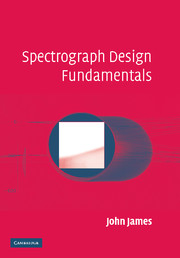Book contents
- Frontmatter
- Contents
- Preface
- Acknowledgements
- 1 A brief history of spectroscopy
- 2 The relevant regions of the electromagnetic spectrum
- 3 Geometrical optics
- 4 Optical aberrations
- 5 Fourier transforms: a brief revision
- 6 Physical optics and diffraction
- 7 The prism spectrograph
- 8 The plane grating spectrograph
- 9 The concave grating spectrograph
- 10 The interference spectrograph
- 11 The multiplex spectrometer
- 12 Detectors
- 13 Auxiliary optics
- 14 Optical design
- 15 Mechanical design and construction
- 16 Calibration
- 17 The alignment of a spectrograph
- Appendix 1 Optical aberrations
- Appendix 2 Wavelengths of spectral lines for calibration
- Appendix 3 The evolution of a Fabry–Perot interference spectrograph
- Appendix 4 The common calibration curve in silver halide spectrophotometry
- Bibliography
- Index
1 - A brief history of spectroscopy
Published online by Cambridge University Press: 02 September 2009
- Frontmatter
- Contents
- Preface
- Acknowledgements
- 1 A brief history of spectroscopy
- 2 The relevant regions of the electromagnetic spectrum
- 3 Geometrical optics
- 4 Optical aberrations
- 5 Fourier transforms: a brief revision
- 6 Physical optics and diffraction
- 7 The prism spectrograph
- 8 The plane grating spectrograph
- 9 The concave grating spectrograph
- 10 The interference spectrograph
- 11 The multiplex spectrometer
- 12 Detectors
- 13 Auxiliary optics
- 14 Optical design
- 15 Mechanical design and construction
- 16 Calibration
- 17 The alignment of a spectrograph
- Appendix 1 Optical aberrations
- Appendix 2 Wavelengths of spectral lines for calibration
- Appendix 3 The evolution of a Fabry–Perot interference spectrograph
- Appendix 4 The common calibration curve in silver halide spectrophotometry
- Bibliography
- Index
Summary
The earliest reference to optical spectroscopy that we have in modern times appears to be the phenomenon of colours in Isaac Newton's Opticks, in which he describes his famous experiments with prisms and the shaft of sunlight coming through the hole in his window shutter. There was much philosophical conjecture at the time but scientific silence from then on until William Hyde Wollaston (1766–1828) in 1802, also in Cambridge, used a lens to focus images of a narrow, sunlight-illuminated slit through a prism on to a screen. Wollaston appears to have observed the dark lines across the spectrum transverse to the dispersion direction but ascribed them to the divisions between the colours. He may be forgiven for this, because with a single lens the spectral resolution would have been derisory. At about the same time William Herschel (1738–1822) discovered the infra-red radiation by the rise in temperature of the bulb of a thermometer when he held it beyond the red part of the spectrum in his spectroscope. Joseph von Fraunhofer (1787–1826) saw more dark lines but did not guess or deduce their origin. The currently accepted explanation – the absorption of continuous white light by vapours in the atmosphere of the Sun – was given by Gustav Kirchhoff and Robert Bunsen in the University of Heidelberg who, we may be reasonably certain, passed a collimated beam through their prism before focusing it, and thereby secured a reasonable resolution.
- Type
- Chapter
- Information
- Spectrograph Design Fundamentals , pp. 1 - 5Publisher: Cambridge University PressPrint publication year: 2007



